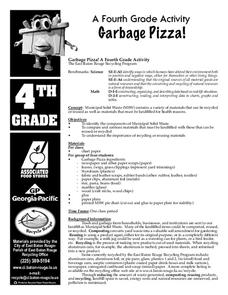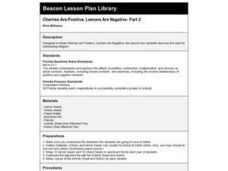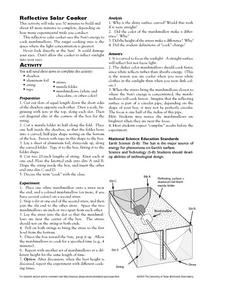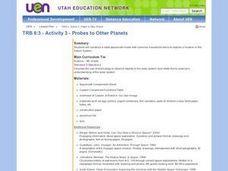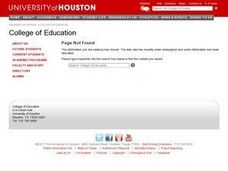Curated OER
Habits of Mind
Students study tree leaves to complete the activity, In this tree leaf experiment lesson, students observe, measure, and sort tree leaves individually, in groups, and in relationship to the entire tree.
Curated OER
Garbage Pizza
Fourth graders explore the concept of waste management. In this recycling lesson, 4th graders identify materials that must be landfilled as well as items that may be recycled or reused.
Curated OER
Electrolysis of Water
Ninth graders examine the electrolysis of water by completing an experiment. In this water lesson students will explain how hydrogen can be extracted from water and how energy flows through an electrolysis system.
Curated OER
Chemosynthesis in the Classroom
Students observe the development of chemosynthesis in bacterial communities. In this bacteria lesson students explore that chemosynthesis is and how it is relevant to biological communities.
Curated OER
Cherries Still Positive, Lemons Still Negative
Third graders explore positive and negative integers. This follows a lesson entitled, Cherries Are Positive, Lemons Are Negative and uses Cherry heads and Lemon heads.
Curated OER
What is a Watershed, Anyway?
Students constrct a watershed and write about their observations. Students use maps to locate their area in relation to the watershed and inquire about what is applied to the ground above.
Curated OER
Pinhole Viewer
Students make a pinhole viewer to demonstrate how it inverts light passing through it which produces inverted images.
Curated OER
Build an Electrophoresis Chamber
Students explore electrophoresis, a technique used to isolate DNA. They assemble a gel chamber for separating mixtures. Students observe separation influenced by electric charge. They define separation through gel electrophoresis.
Curated OER
Mirror, Mirror on the Wall, Who Needs Math in Life at All?
Students think and talk about the ways in which they use math throughout the day. They add each way to a "math in real life" bulletin board and reflect in writing on the ways they use math.
Curated OER
Cherries Are Positive, Lemons Are Negative- Part 2
Third graders, in groups, subtract integers by following Cherries are Positive, Lemons are Negative. They discover the rules for subtracting integers by using cherry heads and lemon heads.
Curated OER
Reflective Solar Cooker
Students build and use a reflective solar cooker to cook marshmallows.
Curated OER
Will it Float?
First graders discuss why some things sink and some float after dropping a variety of items into water.
Curated OER
WHY WE AREN'T FILTER FEEDERS
Students describe three methods of obtaining food: scavenging, filter feeding, and hunting. They describe three methods of obtaining food: scavenging, filter feeding, hunting, and list at least two reasons why humans are not considered...
Curated OER
Wetlands/Watershed Model
Students make a model that will demonstrate the flow of surface water across the land in Texas and how materials that originate many miles away can end up in the wetland along the coast.
Curated OER
Testing for Conductivity
Students test the conductivity of selected liquids and solids. They test the circuit by touching the two free ends of the wires together and add salt little by little recording the data after each addition. Finally, students predict...
Curated OER
Probes to Other Planets
Sixth graders use a list of robot components and common household items to design and construct a robot spacecraft model suitable for exploring the Saturn System. They present the robots to the class.
Curated OER
Buoyancy: What will float and what will sink
Students write and explain why an object sinks or floats. In this buoyancy lesson students demonstrate how items float or sink and graph the results.
Curated OER
Spectral Surprise
Students experience a model that produces, separating, and displaying spectral colors.
Curated OER
Wetlands/Watershed Model
Students work together to create a watershed model. They discover the flow of surface water on different topography. They examine how materials originate from miles away and end up in a different wetland.
Curated OER
Wonderful Water
Students identify the various states of water and its natural flow downward. As a class, students take digital pictures of different forms of water and create a multimedia presentation describing their photographs. Groups of students...
Curated OER
Marvelous Magnets
Students identify and classify magnetic and nonmagnetic materials and metals. After determining which materials and metals are magnetic, students create a data table and classify items by two different criteria. Students e-mail various...
Curated OER
VISUAL ARTS LESSON-Missal Stand/Lectern
Sixth graders investigate a work of art from Mexico. The role of the art in the history of Mexico is researched to help evaluate the meaning of the artwork. The art creates a context for students to make a creative project.
Curated OER
Oklahoma Ag in the Classroom
Students read a recipe of beef jerky and explore the process. In this agriculture recipe instructional activity, students read the process and recipe for creating beef jerky. Students also read a history of the American Plains...
Curated OER
Not a Drop to Drink
Pupils design an experiment to determine which liquid is water. In this chemistry instructional activity, students perform the experiment as outlined in their design. They record observation and formulate conclusion.

